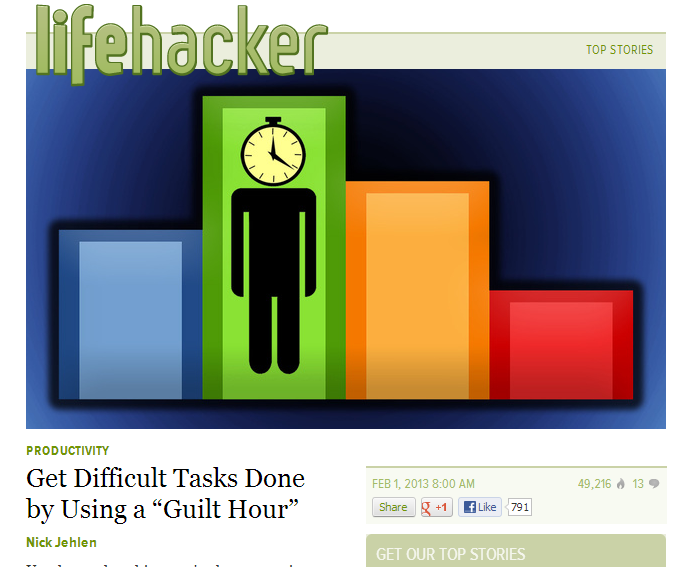
Can Envisioning Your Ideal Day Help You Get More Done?
This is Week 7 of a Year of Living Productively
This week I tested Jason Womack’s technique of envisioning my ideal day each morning. I wrote what I envisioned using idonethis and then followed up by writing how it went. Scroll to the bottom of this post to see what I planned to do this week.
How Envisioning My Ideal Day Saved My Sanity This Week
- Helped me become less task focused. Even though the metric I’ve been using is “getting more done,” the truth is that’s not all I’m after. I want to have peace in knowing I’ve used the gift of this day well. Thinking about my ideal day helped me consider more than just things to do, but people to love, and experiences I wanted to have. That gave me some peace this week.
- Gave me a general guide for the day. I didn’t plan to envision my days this way, but I ended up writing down how I saw the day unfolding, step by step. As long as I kept this guide in mind, it worked well to help me recall what I really wanted my day to look like. It also helped me take all my commitments for the day into account.
- Got me to do things I ordinarily wouldn’t have. I found this was especially true in the evenings when I’m much harder to motivate. I made time for my kids and for reading and I felt great about that.
How Envisioning My Ideal Day Made Me Crazy This Week
- I wasn’t well. I had another week of extreme fatigue and that made thinking about my ideal day that much harder. I finished the week feeling better though and I’m hopeful to be back to normal soon.
- Started off as an unrealistic routine. At first, I approached my ideal day list as a have-to list. That didn’t work well. I felt like I didn’t want to do any of it then. The rebel in me kicked in. But then I reminded myself that this was just a wish list–not a requisition–and it helped a lot. It also helped not referring to it, but just remembering what I’d written.
Did Envisioning My Ideal Day Help Me Get More Done?
Yes. At first I thought my answer was going to be no, but that’s because I expected to do everything I had planned. When I started seeing it as a general guide and not a must-do list, I started seeing progress. I plan to continue doing this mentally, though I don’t plan to continue recording it via idonethis for the time being.
**UPDATE**
I do this now using an app called the 5 Minute Journal. I answer questions about what would make today great. I do believe it makes a difference.
The Productivity Approach I’ll Be Using for Week 8
“Do it tomorrow” doesn’t sound like very wise advice until you read Mark Forster’s book. I read Do It Tomorrow a number of years ago, tried the approach, and failed miserably. Having a number of years of experience in productivity, I decided to give it another try. I re-read the book and I think I understand what went wrong last time and I’m very excited to test it this week.
The concept. Most of us aren’t efficient in getting our work done, because we do things as a reaction. We attend to all kinds of requests as though they were urgent, when most of them aren’t. By waiting a day to do those that aren’t argent, we can organize them to get them done quickly. All the day’s email and paper can be handled at once, for example. The idea is that you are always completing one day’s work rather than an endless stream of tasks. Any work you have now that you’re behind on (including email) is declared a backlog. The first part of your work day is devoted to clearing the backlog–at least 5 minutes every day, and then for as long as you wish. The rest of your day is devoted to working on the tasks that came in yesterday. The idea is that you can stay on top of your work, and if you can’t, you need to figure out why and take steps to address it.
Do it Tomorrow is chock full of ideas for dealing with projects, finding time to work on meaningful goals, and addressing procrastination. It’s a great read! (The links above are affiliate links.) I’ll be using IQTell to manage my Do it Tomorrow approach, but a dated diary works beautifully, too. (Note: My past mistake that I’ll avoid this time was entering many tasks that were really part of my backlog to action the next day.)
If you’d like to join me this week, here’s what you do. 1. Put all work you’re behind on into backlog folders where it’s out of sight. 2. Collect all today’s incoming work and deal with it in batches tomorrow with the goal of completing all of it. If you take action on a project and have more to do on it, re-enter it for the next day. 3. Items that you must action today (because they’re urgent) should be written on a separate list. 4. Spend the first part of every work day clearing your backlog. If you’d rather not order the book, but still want some guidance, search the forum on Mark Forster’s website for DIT.
Click here to see how my week with DIT went.
If you’ve tried envisioning your ideal day to increase your productivity, please vote in the poll below.
Here are the links to the productivity hacks I’ve tried so far:
read more






